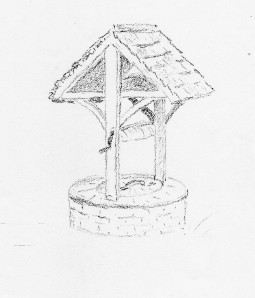The Fernhurst Society
Memories of Fernhurst: agriculture
previous page | next page | Contents
AGRICULTURE
Gone are the days when the village people went to the farms for their milk and eggs, taking their own milk cans. Many cottages had their own cows and pigs and cured their own bacon. Milk was two pence a pint and eggs one shilling for a dozen. One thinks of the farmers, whose humble lives had been devoted to the land their fathers’ farmed before them. It was not an industry, it was a way of life recorded down the years. The farmers loved their horses, one of farmer bemoaned that neither his son nor his grandson loved even the memory of horses, it was always the machines. Wait! The old man had a great surprise. Countrymen are brief sometimes, for, from the darkest corner in the musty stable, came the grandson with his arms full of gleaming brasses. There were bells and swingees, rosettes and elaborated skiffed and studded reins.
It was evening when this took place and the brasses flashed in the last rays of the sun. Emblems such as were the pride of horsemen and carters and farmers, in the days when a man did not count it loss of time to rise early, that he might polish his horse brass ready for a journey. They certainly made a gleaming sight, and the horses always looked proud. The old man was filled with joy that his grandson still treasured this whole set of brasses, but was too shy to let it be known. What a picture to be able to see the horses rigged out again, raising their proud heads. What a memory to be recorded.
In some old barns amongst the dust and cobwebs on the beams hang such all but forgotten tools and properties as flails, barley hummelers, sickles and scythes.
In the winter the men worked in the woods, but in the summer worked in the hayfields during daylight hours, the womenfolk helping. An old resident says ‘When I was a child, haymaking was a communal affair. The blacksmith left his forge, the carpenter his bench, the women their housework and the children stayed home from school to help with the haymaking.
In a fine week you would meet the same group of people. They drank cider made from the Hereford apples grown in the district. William Penfold owned a cider press and went from house to house as requested. Tea was scorned as a drink in the fields. Home brews were drunk instead, with good thick slices of home made bread and cheese and possibly home made butter.
At harvest time the villagers went in family groups to glean in the cornfields.
Each family hoped to glean a bushel of wheat which they took to Cook’s Bridge Mill to be ground into flour which would provide the family with bread during the winter months, truly a harvest.
Yes, there was hard work during haytime and harvest but there was the fun and frolic too, and the song of the reapers as they carried home the corn.
Now the milk is delivered in bottles from the dairy, not the individual farms. The cows are machine milked and some farms have cow parlours where everything for the cow is under one roof, and the dairymen wear overalls. In winter the cows sleep and feed in various parts of the building. Working hours are much shorter, as most things on the farm are done by machinery. The tractor has replaced the horse. The first tractor in Fernhurst was introduced by Sir Felix Schuster at Verdley Place.
Now the combine harvester cuts and thrashes and bags the corn in one operation. Gone is the picture of the stooks standing in the field to dry, as remembered in the days of yore. Before water was laid and the village used well water, we learn that the wells only ran dry when the cows were being watered in the summer time. The well water was very good and the deepest well was owned by Mr Tudor.
The well in Miss Tudor's gardenprevious page | next page | Contents



The Fernhurst Oral History Project was supported by the Local Heritage Initiative. The Local Heritage Initiative was developed by the Countryside Agency and was funded by the Heritage Lottery Fund and Nationwide Building Society.


